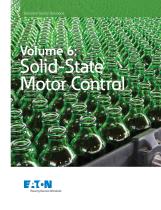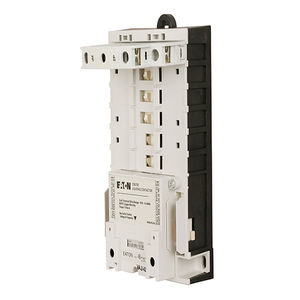
- Electricity - Electronics
- Switch and Relay
- Motor reversing contactor
- Eaton Count Control Products
Power contactor XT seriesmotor reversingelectromechanicalvacuum


Add to favorites
Compare this product
Characteristics
- Function
- power, motor reversing
- Technology
- electromechanical, vacuum
- Electrical characteristics
- DC, 4-pole
- Other characteristics
- IEC
- Primary current
200 A
Description
Small size. Big impact.
The XT IEC contactors are powerful, efficient and versatile, and can be combined with our full range of electronic overload relays and bimetal relays. These DC devices stand out for their reduced power consumption, which makes them more energy efficient and also reduces the size of the power supply units. XT IEC contactors are suitable for global use and cover the entire output range, from mini contactor relays (up to 7 A) all the way to vacuum contactors (up to 3180 A).
Core features of XT IEC contactors
• Up to 170 A
• Frame sizes: 45 mm for up to 32 A; 55 mm for up to 72 A; and 90 mm for up to 170 A
• Temperature range –25 °C to +60 °C
• Four-pole contactor up to 200 A
• Uniform accessories for three-pole and four-pole contactors
• Double box terminals for reliable wiring of different cross-sections
• The contactors up to 38 A can be controlled directly from a PLC
• DC-operated devices with integrated suppressor circuits
Small size. Big impact.
“Grossi Electric has learned a lot from Eaton’s innovative expertise, support and collaborative design approach,” concluded Mike Grossi. “Eaton is now a critical partner in our company’s ongoing evolution and long-term growth plans.”
Explore how Eaton’s XT IEC contactors and other control products streamlined processes, enabling a clean and affordable panel design for Grossi Electric.
VIDEO
Catalogs
NEMA Contactors and Starters
154 Pages
IEC Contactors and Starters
259 Pages
Exhibitions
Meet this supplier at the following exhibition(s):

Other Eaton Count Control Products products
Contactors and starters
Related Searches
- Surge protector
- Switching relay
- Eaton circuit breaker
- Protection relay
- Isolator switch
- Type 2 surge protector
- Contactor
- Monitoring relay
- Type 1 surge protector
- Electromechanical relay
- Time relay
- AC surge protector
- DC electromechanical relay
- Multipole surge protector
- DIN rail monitoring relay
- SSR
- Switchgear
- Digital protection relay
- AC contactor
- Compact surge protector
*Prices are pre-tax. They exclude delivery charges and customs duties and do not include additional charges for installation or activation options. Prices are indicative only and may vary by country, with changes to the cost of raw materials and exchange rates.








